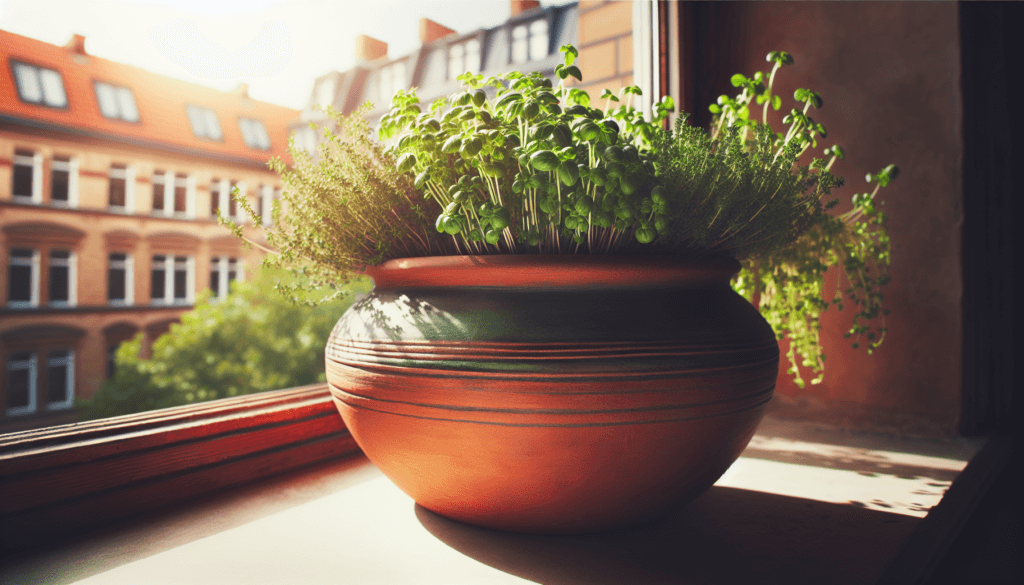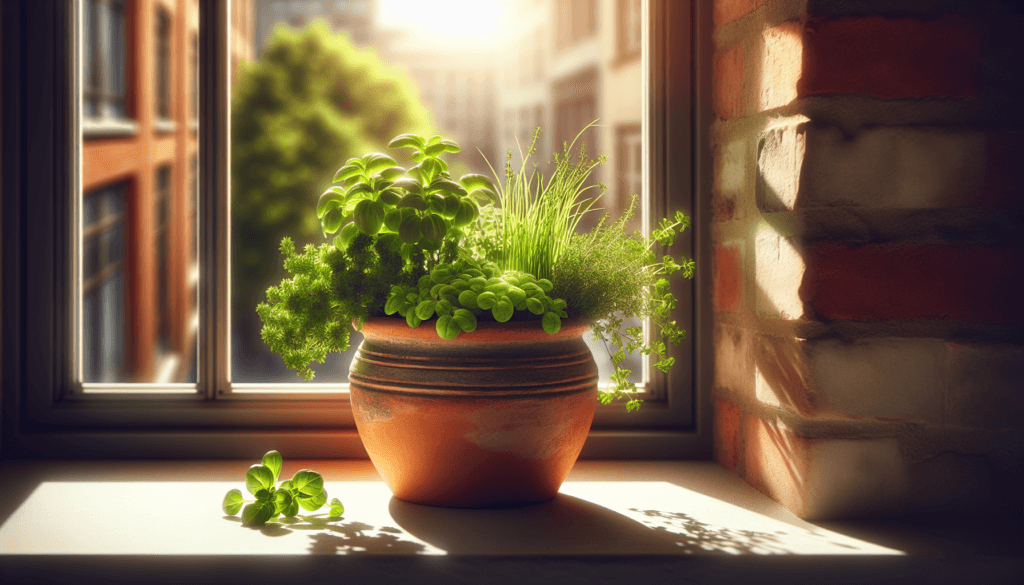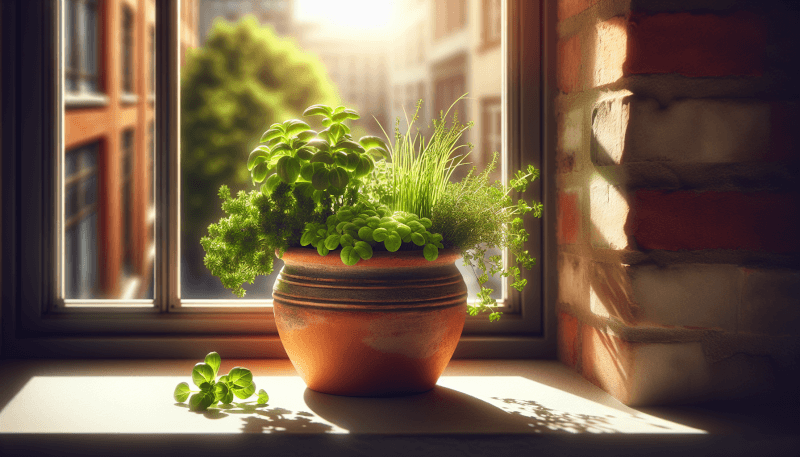If you’ve always wanted to create your own green oasis in the midst of the bustling city, but haven’t known where to start, look no further. We have compiled a list of 10 easy urban gardening ideas that are perfect for beginners like you. Whether you have a small balcony, a corner in your backyard, or even just a sunny windowsill, these ideas will help you transform any space into a thriving garden. From vertical gardens to container gardening, these simple techniques will have you feeling like a seasoned urban gardener in no time. So grab your gardening gloves and get ready to embark on a green adventure!
Container Gardening
Choosing the Right Containers
Container gardening is a great way to bring a touch of nature to your urban space, whether you have a small balcony or a windowsill. When it comes to choosing the right containers for your plants, there are a few important factors to consider. First, you’ll want to make sure your containers have adequate drainage holes to prevent waterlogging and root rot. Additionally, choose containers that are the appropriate size for your plants’ root systems to ensure they have enough room to grow. Finally, opt for containers made of materials like plastic, ceramic, or metal, which are durable and lightweight.
Selecting Suitable Plants for Containers
When it comes to selecting plants for your container garden, there are a few factors to keep in mind. First, consider the amount of sunlight your space receives. Some plants, like herbs and vegetables, thrive in full sun, while others, like ferns and hostas, prefer shadier conditions. Additionally, choose plants that are compact and well-suited for containers. Some popular choices for container gardening include herbs like basil and rosemary, flowers like petunias and marigolds, and vegetables like tomatoes and peppers.
Providing Adequate Drainage
Proper drainage is essential for container gardening success. Without adequate drainage, excess water can accumulate and drown your plants’ roots. One way to ensure adequate drainage is to use potting mix specifically designed for containers. These mixes are often formulated with materials like perlite or vermiculite, which help improve drainage. Additionally, make sure your containers have drainage holes in the bottom to allow excess water to escape. If your containers don’t have drainage holes, you can drill some yourself or use a layer of gravel at the bottom to create a reservoir for excess water.
Creating a Container Garden Layout
Creating a thoughtful container garden layout can add beauty and functionality to your urban space. Start by considering the available space you have and any limitations, such as weight restrictions on balconies or limited sunlight on windowsills. Then, plan out the placement of your containers, keeping in mind the different needs of your plants. Group plants with similar water, light, and nutrient requirements together to make maintenance easier. Consider using various heights and textures to add visual interest, and don’t be afraid to experiment with different container arrangements until you find what works best for your space.
Vertical Gardening
Utilizing Wall Space for Planters
If you have limited floor space but plenty of vertical wall space, utilizing wall planters can be a great way to expand your urban garden. Wall planters come in a variety of styles and sizes, allowing you to grow a wide range of plants vertically. Whether you choose to install individual wall-mounted planters or create a living wall with multiple shelves, utilizing your wall space can add greenery and visual appeal to your urban environment.
Installing Hanging Baskets
Hanging baskets are another excellent option for vertical gardening in urban spaces. Hanging baskets allow you to bring plants at eye level, adding a decorative touch and maximizing limited space. You can hang baskets from walls, railings, or hooks, depending on your available space. Choose plants that cascade or have trailing growth habits, such as ivy or trailing petunias, to create a lush and vibrant display.
Constructing a Trellis for Climbing Plants
If you’re looking to grow climbing plants like tomatoes, cucumbers, or morning glories, constructing a trellis is a must. A trellis provides support for the plants’ vines as they grow vertically, allowing them to reach their full potential. You can purchase pre-made trellises or create your own using materials like bamboo stakes or wire mesh. Be sure to secure the trellis properly to ensure stability, especially if you’re growing heavy or large plants.
Using Vertical Planters or Pallets
Vertical planters or pallets are an innovative way to maximize space in urban gardening. These planters are designed with multiple levels or compartments, allowing you to grow a variety of plants in a small footprint. Vertical planters are particularly useful for growing herbs, salad greens, or small flowering plants. They can be freestanding or attached to walls, making them a versatile option for urban gardeners with limited space.

Windowsill Gardens
Selecting Appropriate Windows for Gardening
Windowsill gardens are an ideal option for urban dwellers without access to outdoor space. When selecting windows for gardening, it’s important to consider a few key factors. First, choose windows that receive ample sunlight throughout the day. Most edible plants require at least 6-8 hours of direct sunlight to thrive. South-facing windows are typically the best choice, as they receive the most sunlight. Additionally, ensure your windows are easily accessible for watering and maintenance.
Choosing Compact Plants for Windowsills
Since windowsill gardens have limited space, it’s essential to choose compact plants that can thrive in small containers. Look for varieties that are specifically bred for container gardening or have a naturally compact growth habit. Herbs like mint, chives, and thyme are excellent choices for windowsill gardens, as they are compact, aromatic, and can be easily harvested for culinary use. Other options include small flowering plants like pansies or petunias, or even small vegetable varieties like cherry tomatoes or mini peppers.
Providing Ample Sunlight and Ventilation
Sunlight and ventilation are crucial for the success of your windowsill garden. As mentioned earlier, choose windows that receive at least 6-8 hours of direct sunlight each day. If your windows are partially shaded, consider supplementing natural sunlight with artificial grow lights. Additionally, proper ventilation is essential to prevent excessive humidity and fungal diseases. You can open your windows periodically or use a small fan to promote air circulation.
Using Self-Watering Systems for Convenience
If you’re concerned about the hassle of watering your windowsill garden, consider using self-watering systems. Self-watering containers have a reservoir at the bottom that holds water, allowing the plants to draw moisture as needed. These systems can significantly reduce the frequency of watering, making them a convenient option for busy urban gardeners. Just be sure to monitor the water level in the reservoir to prevent overwatering or drying out of the plants.
Herb Gardens
Establishing an Indoor Herb Garden
Indoor herb gardens are a fantastic way to have fresh herbs at your fingertips all year round. To establish an indoor herb garden, start by choosing a sunny location, such as a windowsill or a well-lit area. Next, select herbs that are well-suited for indoor growing, such as basil, parsley, or cilantro. Finally, plant your herbs in appropriately sized containers with good drainage, using a well-draining potting mix. Place them near a natural light source or use artificial grow lights to ensure they receive adequate light.
Growing Herbs in Small Spaces
If you’re dealing with limited space, growing herbs vertically or in compact containers is an excellent solution. Vertical herb gardens can be created using wall-mounted planters or hanging baskets, utilizing your vertical space efficiently. Alternatively, you can choose compact herb varieties or use multi-tiered herb planters to maximize your growing area. Some herbs are naturally compact, such as thyme or oregano, making them ideal for small spaces.
Planting Herbs in Vertical Herb Walls
Vertical herb walls are a trendy and space-saving way to grow herbs indoors. These walls are made up of individual planting pockets, allowing you to grow multiple herbs in a vertical arrangement. To create a vertical herb wall, you can purchase a pre-made system or build one yourself using materials like pallets or PVC pipes. It’s important to ensure proper drainage and provide adequate water and nutrients to your herbs in a vertical setup.
Maintaining Proper Moisture and Nutrient Balance
To ensure the health and productivity of your herb garden, it’s critical to maintain proper moisture and nutrient balance. Herbs generally prefer slightly moist but well-draining soil, so it’s important not to overwater them. Allow the top inch of soil to dry out between waterings, and be sure any excess water drains away to prevent root rot. Additionally, herbs benefit from regular feeding with a balanced liquid fertilizer to ensure they receive essential nutrients for growth and flavor development.

Balcony Gardens
Determining Balcony Size and Weight Limitations
Before creating a balcony garden, it’s essential to determine the size and weight limitations of your balcony. Balconies have different weight-bearing capacities, and it’s important to ensure that your gardening endeavors will not exceed these limitations. Consult with a structural engineer or building management if you’re unsure about the weight capacity of your balcony. Knowing these constraints will help you plan your garden and choose appropriate containers and materials accordingly.
Creating a Balcony Garden Design
Creating a well-planned and aesthetically pleasing balcony garden design is key to maximizing your space and creating a welcoming environment. Consider the style and theme you want to achieve, whether it’s a vibrant flower-filled balcony or a serene, Zen-inspired oasis. Choose containers and plants that complement your desired aesthetic and ensure they fit well within the available space. Don’t hesitate to get creative with vertical planters, hanging baskets, and trellises to make the most of your balcony’s vertical space.
Choosing Suitable Pots and Containers
Choosing suitable pots and containers for your balcony garden is crucial for both the health of your plants and the overall aesthetic of your space. Opt for lightweight containers made of materials like plastic or resin to prevent unnecessary strain on your balcony. Ensure the containers have adequate drainage holes and are the appropriate size for your plants’ root systems. Consider using a mix of different container sizes and heights to add visual interest and accommodate a variety of plants.
Including Decorative Elements and Trellises
To enhance the appeal of your balcony garden, consider including decorative elements and trellises. Decorative elements, such as colorful planters or garden ornaments, can add personality and visual interest to your space. Trellises are particularly useful for vertical gardening and can serve as a decorative focal point. Choose trellises that complement your balcony’s style and use them to support climbing plants like jasmine or sweet peas.
Microgreens and Sprouts
Understanding Microgreens and Sprouts
Microgreens and sprouts are nutrient-dense and flavorful young plants that are harvested at an early stage of growth. Microgreens are typically harvested when they have developed their first set of true leaves, while sprouts are harvested when they have just germinated and have small, tender shoots. These tiny greens and sprouts are easy to grow indoors and provide a quick and nutritious addition to salads, sandwiches, and other dishes.
Selecting Seeds for Quick Indoor Harvesting
When selecting seeds for growing microgreens and sprouts, it’s important to choose varieties that are well-suited for quick indoor harvesting. Look for seeds labeled specifically for microgreens or sprouting, as they have been selected for their tender, flavorful leaves. Popular choices for microgreens include kale, radish, and sunflower, while sprouts can be grown from seeds like alfalfa, mung beans, or broccoli.
Preparing Growing Medium for Microgreens
A suitable growing medium is essential for successful microgreen cultivation. While there are specialized soil mixes available for microgreens, you can also use a mix of vermiculite or coconut coir and compost or potting soil. Fill your chosen container with the growing medium, ensuring it is evenly distributed and not packed too tightly. Moisten the growing medium before sowing the seeds, and keep it consistently moist throughout the growing process.
Caring for Microgreens and Sprouts
Proper care is essential to ensure the healthy growth of microgreens and sprouts. After sowing the seeds, cover the container with a plastic lid or a plastic wrap to create a humid environment for germination. Once the seeds have germinated, remove the cover and place the container in a well-lit area. Rotate the container daily to ensure even growth, and water as needed to keep the growing medium moist. After a few weeks, when the microgreens or sprouts have reached the desired size, carefully harvest them, wash them, and enjoy their fresh flavors.

Indoor Vegetable Gardening
Selecting Vegetables Suitable for Indoor Gardening
While many vegetables thrive in outdoor gardens, there are several varieties that can be successfully grown indoors. When selecting vegetables for indoor gardening, consider plants that are well-suited for small spaces and have a relatively short growing season. Some excellent choices for indoor vegetable gardening include leafy greens like lettuce and spinach, compact varieties of tomatoes and peppers, and herbs like basil and parsley. Choose vegetables that are suited to the amount of light and space available in your indoor environment.
Providing Sufficient Light and Heat
Light and heat are crucial factors for successful indoor vegetable gardening. Most vegetables require at least 6-8 hours of direct sunlight each day to grow and produce fruits. If your indoor space lacks natural sunlight, you can supplement with artificial grow lights. Position the lights at the appropriate distance from the plants and ensure they are on for the recommended number of hours each day. Additionally, maintaining a consistent temperature between 65-75°F (18-24°C) will optimize growth and ensure the plants are comfortable.
Choosing the Right Containers and Soil Mix
Choosing the right containers and soil mix is essential for healthy indoor vegetable growth. Consider using containers made of lightweight and durable materials like plastic or resin. Make sure the containers have adequate drainage holes and are the appropriate size for your plants’ root systems. When it comes to soil, a well-draining potting mix formulated for vegetables is ideal. This type of mix is usually lighter and enriched with nutrients to support healthy growth. Avoid garden soil, as it can be too heavy and may contain pests or diseases.
Watering and Fertilizing Indoor Vegetables
Proper watering and fertilization are critical for the success of indoor vegetable gardening. Water your vegetables thoroughly until the excess water drains out, and allow the top inch of soil to dry out between waterings. Be careful not to overwater, as this can lead to root rot. Fertilize your indoor vegetables regularly with a balanced, water-soluble fertilizer to ensure they receive essential nutrients. Follow the product instructions for the appropriate dosage and frequency of application, and adjust based on your plants’ needs.
Rooftop Gardens
Assessing Rooftop Weight Load Capacity
Before creating a rooftop garden, it’s important to assess the weight load capacity of your rooftop. Rooftops have varying weight restrictions, and it’s crucial to ensure that your garden will not exceed these limitations. Consult with a structural engineer or building management to determine the load capacity and any necessary reinforcements for your rooftop. Knowing these constraints will help you design and build a rooftop garden that is safe and structurally sound.
Creating a Rooftop Garden Design
Creating an aesthetically pleasing and functional rooftop garden design is essential for maximizing your space and creating an urban oasis. Start by evaluating your rooftop’s layout and available space. Consider incorporating various elements like raised beds, containers, seating areas, and pathways to create a cohesive and inviting space. Pay attention to the overall harmony of the design, ensuring that plants and decorative elements complement each other and create a balanced and visually appealing rooftop garden.
Choosing Plants Adapted to Rooftop Conditions
Rooftops often present challenging growing conditions, including exposure to wind, intense sunlight, and limited access to water. When choosing plants for your rooftop garden, opt for varieties that are adapted to these conditions. Drought-tolerant plants like sedums, succulents, and ornamental grasses are excellent choices. Additionally, consider incorporating native plant species, which are naturally adapted to the local climate and may require less maintenance. Be mindful of your specific rooftop microclimate and choose plants accordingly.
Implementing Proper Irrigation Systems
Proper irrigation is crucial to ensure the health and vitality of your rooftop garden. Installing an efficient irrigation system will help conserve water and ensure your plants receive the moisture they need. Drip irrigation systems, soaker hoses, or automated sprinklers are all viable options for rooftop gardens. Consider incorporating rainwater harvesting systems to collect and reuse rainwater for irrigation, reducing your reliance on municipal water supplies. Regularly monitor your irrigation system to ensure it is functioning properly and adjust watering schedules as needed.

Community Gardens
Finding and Joining Community Gardens
Community gardens provide a wonderful opportunity for urban dwellers to connect with nature and their neighbors while growing their own food. To find and join a community garden, start by contacting local gardening clubs, community centers, or your municipal government. They can provide information about existing community gardens in your area and any membership requirements. You may need to fill out an application and pay a small fee to join a community garden, but the benefits of shared knowledge, resources, and camaraderie are well worth it.
Contributing to the Community Garden Maintenance
Being part of a community garden means sharing not only the joys but also the responsibilities of maintenance. It’s important to contribute to the upkeep of the community garden by participating in regular maintenance tasks. This can include weeding, watering, planting, and general upkeep of common areas. Regularly attending garden workdays or scheduled maintenance events is a great way to get involved and give back to the community.
Planning and Designing Plots in a Community Garden
When planning and designing your plot in a community garden, take into consideration the available space, sunlight exposure, and the requirements of the plants you wish to grow. Consult with fellow gardeners or the garden manager to ensure your plot is in compliance with any rules or guidelines set by the community garden. Consider using raised beds or containers to maximize space and make maintenance more manageable. Take pride in creating a plot that reflects your personal gardening style and adds beauty to the community garden.
Collaborating with Other Gardeners
One of the greatest benefits of participating in a community garden is the opportunity to collaborate and learn from fellow gardeners. Take advantage of this shared knowledge by engaging with other gardeners, asking for advice, and sharing your own experiences. Collaborate on projects like communal herb gardens or collectively maintaining common areas. By fostering a spirit of collaboration and community, you can create an enriching and enjoyable gardening experience for everyone involved.
Aquaponics
Understanding the Aquaponics System
Aquaponics is a sustainable and efficient gardening method that combines aquaculture (raising fish) with hydroponics (growing plants without soil). In an aquaponics system, fish waste provides nutrients for the plants, while the plants act as a natural filter, purifying the water for the fish. This symbiotic relationship allows for the cultivation of fish and plants in a closed-loop system, with minimal water usage and no need for chemical fertilizers.
Setting Up an Aquaponics Garden
Setting up an aquaponics garden can be done indoors or outdoors, depending on your available space and climate. You’ll need a fish tank or pond for the aquatic life and a grow bed or containers for the plants. The two components are connected through a water pump or gravity flow system that circulates the nutrient-rich water from the fish tank to the plant containers. It’s essential to properly cycle the system to establish the necessary bacteria for breaking down fish waste into plant-available nutrients.
Choosing Suitable Aquatic and Terrestrial Plants
Aquaponics allows for the cultivation of a wide range of aquatic and terrestrial plants. For the aquatic component, choose hardy and fast-growing fish species like tilapia, trout, or koi. These fish will produce ample waste to provide nutrients for the plants. When selecting terrestrial plants, opt for varieties that are well-suited for hydroponic growth and have a high tolerance for fluctuations in moisture levels. Leafy greens, herbs, and vine crops like tomatoes or cucumbers are popular choices for aquaponic gardens.
Maintaining Water Quality and Fish Health
Maintaining water quality and fish health is of utmost importance in an aquaponics system. Regularly monitor the water parameters, including temperature, pH, ammonia levels, and nitrate levels, to ensure they remain within the optimal range for both fish and plants. Use a water testing kit to measure these parameters and make any necessary adjustments. Maintain a balance between fish stocking density and plant uptake to prevent overcrowding and promote healthy fish growth. Regularly clean and inspect the system, ensuring proper filtration and circulation of water.



